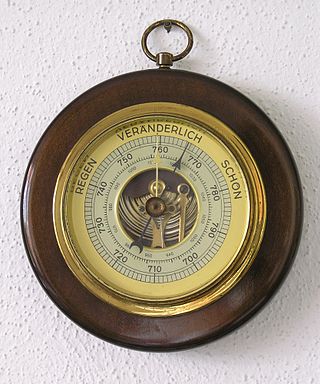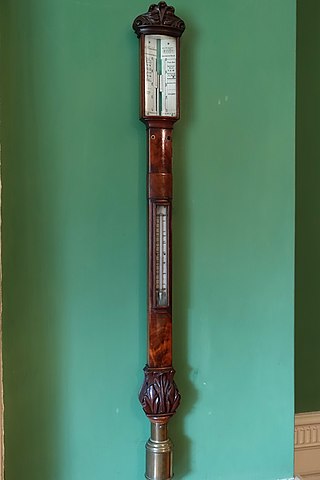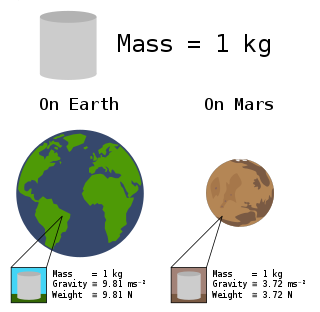Related Research Articles

Pressure is the force applied perpendicular to the surface of an object per unit area over which that force is distributed. Gauge pressure is the pressure relative to the ambient pressure.
The torr is a unit of pressure based on an absolute scale, defined as exactly 1/760 of a standard atmosphere. Thus one torr is exactly 101325/760 pascals.

Relative density, also called specific gravity, is a dimensionless quantity defined as the ratio of the density of a substance to the density of a given reference material. Specific gravity for solids and liquids is nearly always measured with respect to water at its densest ; for gases, the reference is air at room temperature. The term "relative density" is preferred in SI, whereas the term "specific gravity" is gradually being abandoned.
Geopotential height or geopotential altitude is a vertical coordinate referenced to Earth's mean sea level that represents the work involved in lifting one unit of mass over one unit of length through a hypothetical space in which the acceleration of gravity is assumed constant. In SI units, a geopotential height difference of one meter implies the vertical transport of a parcel of one kilogram; adopting the standard gravity value, it corresponds to a constant work or potential energy difference of 9.80665 joules.
The pound of force or pound-force is a unit of force used in some systems of measurement, including English Engineering units and the foot–pound–second system.
The kilogram-force, or kilopond, is a non-standard gravitational metric unit of force. It is not accepted for use with the International System of Units (SI) and is deprecated for most uses. The kilogram-force is equal to the magnitude of the force exerted on one kilogram of mass in a 9.80665 m/s2 gravitational field. That is, it is the weight of a kilogram under standard gravity. One kilogram-force is defined as 9.80665 N. Similarly, a gram-force is 9.80665 mN, and a milligram-force is 9.80665 μN.
The density of air or atmospheric density, denoted ρ, is the mass per unit volume of Earth's atmosphere. Air density, like air pressure, decreases with increasing altitude. It also changes with variations in atmospheric pressure, temperature and humidity. At 101.325 kPa (abs) and 20 °C, air has a density of approximately 1.204 kg/m3 (0.0752 lb/cu ft), according to the International Standard Atmosphere (ISA). At 101.325 kPa (abs) and 15 °C (59 °F), air has a density of approximately 1.225 kg/m3 (0.0765 lb/cu ft), which is about 1⁄800 that of water, according to the International Standard Atmosphere (ISA). Pure liquid water is 1,000 kg/m3 (62 lb/cu ft).

The standard atmosphere is a unit of pressure defined as 101325 Pa. It is sometimes used as a reference pressure or standard pressure. It is approximately equal to Earth's average atmospheric pressure at sea level.
The barometric formula is a formula used to model how the pressure of the air changes with altitude.

A millimetre of mercury is a manometric unit of pressure, formerly defined as the extra pressure generated by a column of mercury one millimetre high, and currently defined as exactly 133.322387415 pascals or approximately 133.322 pascals. It is denoted mmHg or mm Hg.
The gravitational metric system is a non-standard system of units, which does not comply with the International System of Units (SI). It is built on the three base quantities length, time and force with base units metre, second and kilopond respectively. Internationally used abbreviations of the system are MKpS, MKfS or MKS . However, the abbreviation MKS is also used for the MKS system of units, which, like the SI, uses mass in kilogram as a base unit.

The U.S. Standard Atmosphere is a static atmospheric model of how the pressure, temperature, density, and viscosity of the Earth's atmosphere change over a wide range of altitudes or elevations. The model, based on an existing international standard, was first published in 1958 by the U.S. Committee on Extension to the Standard Atmosphere, and was updated in 1962, 1966, and 1976. It is largely consistent in methodology with the International Standard Atmosphere, differing mainly in the assumed temperature distribution at higher altitudes.
In fluid mechanics, pressure head is the height of a liquid column that corresponds to a particular pressure exerted by the liquid column on the base of its container. It may also be called static pressure head or simply static head.
Inches of water is a non-SI unit for pressure. It is also given as inches of water gauge (iwg or in.w.g.), inches water column (inch wc, in. WC, " wc, etc. or just wc or WC), inAq, Aq, or inH2O. The units are conventionally used for measurement of certain pressure differentials such as small pressure differences across an orifice, or in a pipeline or shaft, or before and after a coil in an HVAC unit.

In common usage, the mass of an object is often referred to as its weight, though these are in fact different concepts and quantities. Nevertheless, one object will always weigh more than another with less mass if both are subject to the same gravity.
Inertance is a measure of the pressure difference in a fluid required to cause a unit change in the rate of change of volumetric flow-rate with time. The base SI units of inertance are kg m−4 or Pa s2 m−3 and the usual symbol is I.
Standard sea-level conditions (SSL), also known as sea-level standard (SLS), defines a set of atmospheric conditions for physical calculations. The term "standard sea level" is used to indicate that values of properties are to be taken to be the same as those standard at sea level, and is done to define values for use in general calculations.

The cubic metre or cubic meter is the unit of volume in the International System of Units (SI). Its symbol is m3. It is the volume of a cube with edges one metre in length. An alternative name, which allowed a different usage with metric prefixes, was the stère, still sometimes used for dry measure. Another alternative name, no longer widely used, was the kilolitre.
Vertical pressure variation is the variation in pressure as a function of elevation. Depending on the fluid in question and the context being referred to, it may also vary significantly in dimensions perpendicular to elevation as well, and these variations have relevance in the context of pressure gradient force and its effects. However, the vertical variation is especially significant, as it results from the pull of gravity on the fluid; namely, for the same given fluid, a decrease in elevation within it corresponds to a taller column of fluid weighing down on that point.